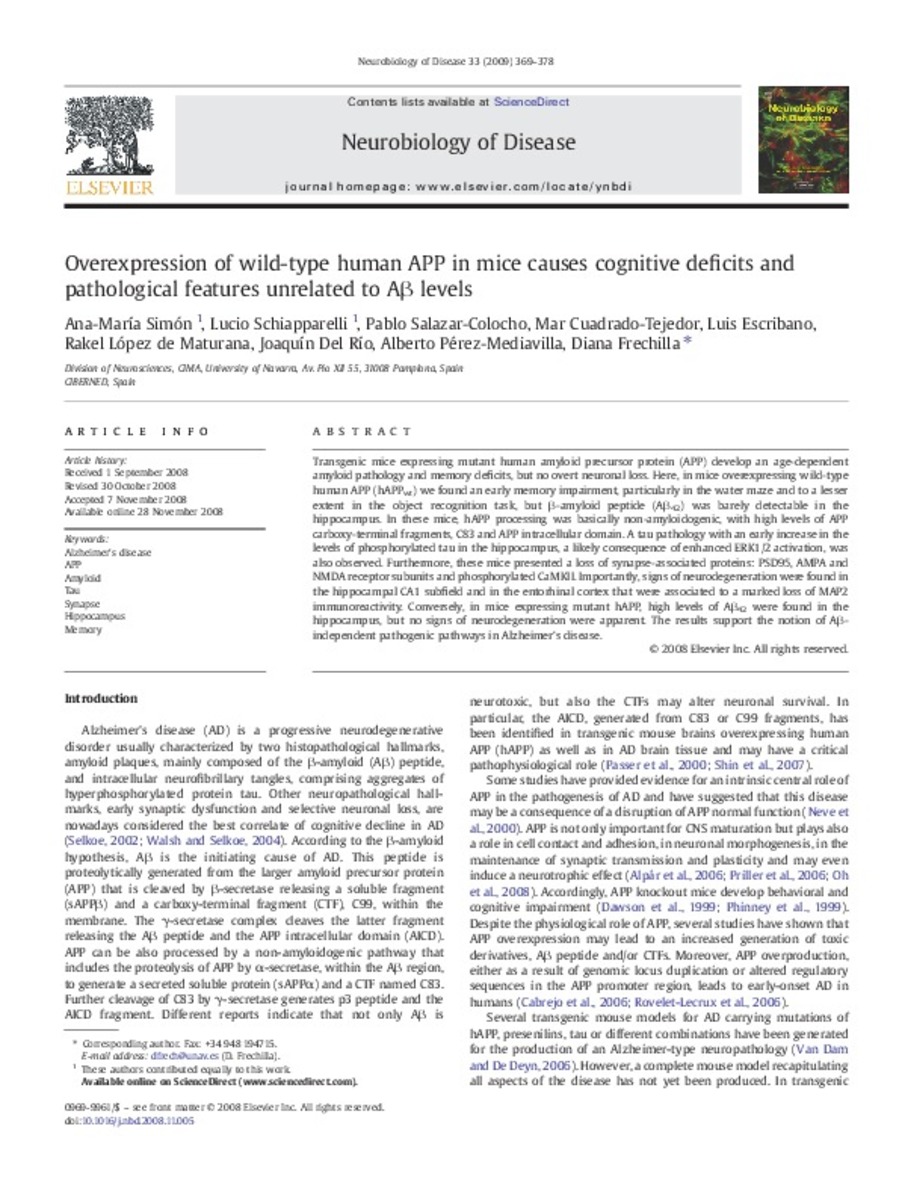Full metadata record
| DC Field | Value | Language |
|---|---|---|
| dc.creator | Simon, A.M. (Ana María) | |
| dc.creator | Schiapparelli, L. (Lucio) | |
| dc.creator | Salazar-Colocho, P. (Pablo) | |
| dc.creator | Cuadrado-Tejedor, M. (Mar) | |
| dc.creator | Escribano, L. (Luis) | |
| dc.creator | Raquel | |
| dc.creator | Rio, J. (Joaquín) del | |
| dc.creator | Perez-Mediavilla, L.A. (Luis Alberto) | |
| dc.creator | Frechilla, D. (Diana) | |
| dc.date.accessioned | 2011-02-11T11:34:06Z | - |
| dc.date.available | 2011-02-11T11:34:06Z | - |
| dc.date.issued | 2009-03 | - |
| dc.identifier.citation | Simon AM, Schiapparelli L, Salazar-Colocho P, Cuadrado-Tejedor M, Escribano L, Lopez de Maturana R, et al. Overexpression of wild-type human APP in mice causes cognitive deficits and pathological features unrelated to Abeta levels. Neurobiol Dis 2009 Mar;33(3):369-378. | es_ES |
| dc.identifier.issn | 0969-9961 | - |
| dc.identifier.uri | https://hdl.handle.net/10171/16499 | - |
| dc.description.abstract | Transgenic mice expressing mutant human amyloid precursor protein (APP) develop an age-dependent amyloid pathology and memory deficits, but no overt neuronal loss. Here, in mice overexpressing wild-type human APP (hAPPwt) we found an early memory impairment, particularly in the water maze and to a lesser extent in the object recognition task, but β-amyloid peptide (Aβ42) was barely detectable in the hippocampus. In these mice, hAPP processing was basically non-amyloidogenic, with high levels of APP carboxy-terminal fragments, C83 and APP intracellular domain. A tau pathology with an early increase in the levels of phosphorylated tau in the hippocampus, a likely consequence of enhanced ERK1/2 activation, was also observed. Furthermore, these mice presented a loss of synapse-associated proteins: PSD95, AMPA and NMDA receptor subunits and phosphorylated CaMKII. Importantly, signs of neurodegeneration were found in the hippocampal CA1 subfield and in the entorhinal cortex that were associated to a marked loss of MAP2 immunoreactivity. Conversely, in mice expressing mutant hAPP, high levels of Aβ42 were found in the hippocampus, but no signs of neurodegeneration were apparent. The results support the notion of Aβ- independent pathogenic pathways in Alzheimer's disease. | es_ES |
| dc.language.iso | eng | es_ES |
| dc.publisher | Elsevier | es_ES |
| dc.rights | info:eu-repo/semantics/openAccess | es_ES |
| dc.subject | Alzheimer's disease | es_ES |
| dc.subject | Memory | es_ES |
| dc.subject | Hippocampus | es_ES |
| dc.subject | Synapse | es_ES |
| dc.subject | Tau | es_ES |
| dc.subject | Amyloid | es_ES |
| dc.subject | APP | es_ES |
| dc.title | Overexpression of wild-type human APP in mice causes cognitive déficits and pathological features unrelated to Abeta levels | es_ES |
| dc.type | info:eu-repo/semantics/article | es_ES |
| dc.identifier.doi | http://dx.doi.org/10.1016/j.nbd.2008.11.005 | es_ES |
Files in This Item:
Statistics and impact
Items in Dadun are protected by copyright, with all rights reserved, unless otherwise indicated.






